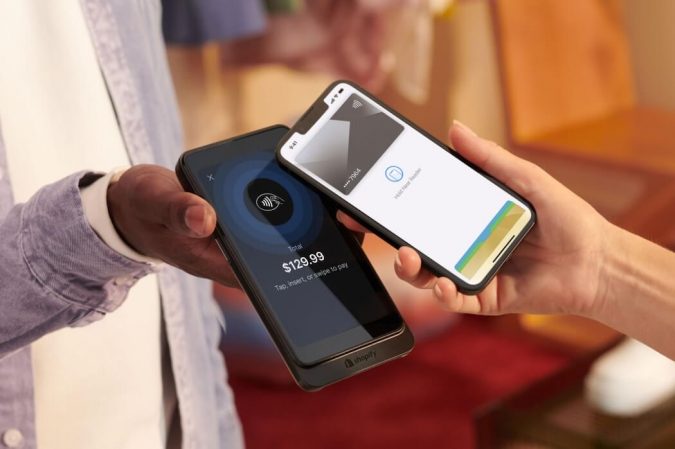
As e-commerce giant Shopify looks to recover from e-commerce growth falling back to earth after the COVID-19 boom, the Canadian company is emphasizing brick-and-mortar once again. Shopify has announced its latest point of sale (POS) product, titled POS Go, which the company described as an all-in-one, POS mobile selling device.
Shopify called Go a net new piece of retail hardware built specifically to run Shopify’s POS. Shopify first launched its POS software in 2013 and then relaunched it in 2020.
”With offline retail all the way back, we’re investing heavily in hardware.”
According to Shopify, Go enables merchants to close sales anywhere; view detailed product information, customer notes, and purchase history; and accept tap, swipe, and chip cards through a card reader. It also allows retailers to view sales, analytics, and inventory across every channel. Go can be used in any place where a WiFi connection is available.
Arpan Podduturi, VP of product at Shopify, told BetaKit that Go was purpose-built to run the company’s revamped POS software, first announced in May 2020. “We built POS Go because we know that retail evolves quickly and merchants need flexible solutions to help them succeed,” Podduturi said.
“With offline retail all the way back, we’re investing heavily in hardware that’s fit for the fast-growing, most innovative retailers in the world,” he said.
Go broadens the range of features available in Shopify POS. Which combined online and in-person sales; the ability to manage inventory in real-time across all channels; and insights on store reporting and performance; as well as offering mobile checkouts.
“Commerce is happening all around us—online, offline, and everywhere in between,” Shopify noted in the release for Go. “As the commerce platform for millions of merchants all over the world, Shopify makes it possible to sell anywhere, including brick-and-mortar stores.”
RELATED: Shopify rolls out new employee compensation system to recruit, retain talent amid stock slump
Podduturi noted Shopify is heavily investing in its retail business. He said that retail has been in Shopify’s DNA for nearly a decade after the company first launched its POS software in 2013. “In 2020 we rebuilt our POS to help us power larger brick-and-mortar retailers,” he added.
“That has translated to a clear acceleration for the business: in the first half of 2022, sales made by merchants using Shopify’s point-of-sale grew nearly 60 percent. We’ll continue to build innovative products for brick-and-mortar retailers, both software and hardware, so expect to hear more from us soon.”
A renewed focus on Shopify’s part toward brick-and-mortar shouldn’t come as a surprise post-COVID-19.
“[Q4] was the best quarter ever for retail business on Shopify.”
When the pandemic hit, Shopify “threw away” its roadmap and bet that e-commerce rather than physical retail would permanently leap ahead by five or even 10 years in terms of revenues, according to a memo company CEO Tobi Lütke shared with staff.
“It’s now clear that bet didn’t pay off,” Lütke added. “Ultimately, placing this bet was my call to make and I got this wrong. Now, we have to adjust.”
The firm has since made layoffs and key executive changes.
Even so, Shopify’s renewed focus on offline POS comes as no surprise, given statements made by company leadership earlier this year. On a call with investors in February, Amy Shapero, Shopify’s CFO (until October 27), noted that Shopify’s Payments and POS solutions represent “a significant opportunity for us,” while company president Harley Finkelstein said that many of the company’s e-commerce merchants are starting to adopt POS in their retail locations (Allbirds and French Connection being two).
“[Q4] was the best quarter ever for retail business on Shopify,” Finkelstein said at the time.
Other new features in Go include a built-in barcode scanner that allows merchants to check out items anywhere in-store; the ability for merchants to build carts in-store and email them to customers for completion later; and the means to take payments confidentially.
RELATED: How tech leaders like Shopify are TV-ifying the traditional company meeting
Shopify’s competition in the POS space includes Lightspeed Commerce, which continues to make gains not only in the restaurant industry but also within retail broadly; Square, which has has had a mobile POS solution for some time now; and Vend, which has a Toronto POS network.
According to Fortune Business Insights, the POS global market value in 2021 was worth $22 billion USD and is projected to grow to $70.7 billion USD by 2029. The retail market segment is expected to hold the largest share because it is time and cost-efficient, according to the study, and provides real-time data about sales performance.
Shopify’s re-embrace of brick-and-mortar is not its only strategy to deal with the broader market downturn. The company launched a new program in August to help creators find partnerships with businesses for free. Called Shopify Collabs, Shopify is hoping the new tool will “cement” it as “the creator’s commerce platform of choice” as it furthers its social commerce strategy.
RELATED: Shopify’s Q2 2022 growth continued to slow amid changing e-commerce market conditions
The company has also pursued a number of strategic investments, including with Boston-based marketing automation software provider Klaviyo, and Single, a Nashville-based, Solana blockchain NFT app for Shopify merchants.
Shopify completed its largest acquisition to date in July, purchasing San Francisco-based Deliverr for $1.2 billion to expand its in-house fulfillment network, as it looks to make next-day and two-day delivery available to Shopify merchant customers and better compete with Amazon.
In terms of Shopify Go, Podduturi added: “Continuing to innovate and give merchants tools that help future proof their business, no matter the channel, is our top priority. The retail landscape today looks much different than it did three years ago, and we believe that POS Go will be a vital tool in helping merchants succeed in an ever-shifting industry. When our merchants succeed, we succeed.”
Feature image courtesy Shopify.
.